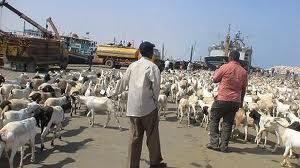Deutsche Presse-Agentur
Tuesday, October 30, 2012

"These sheep and goats are like petroleum for us," Ahmed Ali Nuur, governor of Gabiley, in Somaliland, told dpa. "Saudi Arabia sells barrels of oil to the world. We make our money selling livestock to Saudi Arabia." Somaliland, which is seeking full sovereignty, declared independence after the overthrow of Somali president Siad Barre in 1991. It has been more peaceful than other parts of Somalia, where African Union forces, Islamist militants and warlords are fighting for control.
In the bustling port of Berbera in the semi-autonomous region of Puntland some three million beasts were in recent days loaded on vessels bound for the Red Sea city of Jeddah and ritual sacrifice during the annual Muslim pilgrimage, the haj. In the main animal market of Hargeisa, capital of Somaliland, goats and sheep sell for 70 dollars. Traders clutch bundles of cash, including the 1,000 Somaliland shilling note that features an image of livestock being loaded aboard vessels.
"Every household here has two or three goats, for meat and milk for their children," said Issa Nur Liban, a veterinarian for the nation-wide Somali Animal Health Services Project. "Breeding animals is our heritage, our style. It's in the mind of everybody." In Somaliland, the number of livestock far outnumbers the estimated 3.5-million population. Tax revenues from exported animals bankroll half of government spending. The state has separate ministries for agriculture, livestock and fisheries.
Across Somalia, animal trading accounts for half of the economy and 80 per cent of foreign earnings. Business has survived despite fighting between Somali and African Union forces and the al-Shabaab Islamist rebels across south and central regions. "When you consider that livestock exports doubled these past three years in a country that was at war, it's amazing," said Isabel Faria de Almeida, a development expert for the European Union in Somalia.
"Increasing exports despite weak institutions and the absence of central government is the paradox of Somalia." The EU is spending 23 million euros (30 million dollars) building loading ramps and quarantine centres to help grow Somalia's livestock economy. Newly elected President Hassan Sheikh Mohamud described agriculture as a "crucial part of my government's recovery plan."
Sold to Saudi Arabia and other lucrative Middle Eastern markets, animals from central and southern Somalia are currently transported northwards for export through Berbera and Bosaso ports at the Gulf of Aden, in Puntland. But that could change, thanks to a new quarantine centre in the capital, Mogadishu, and the liberation of the southern port city of Kismayo, which Kenyan troops seized from al-Shabaab militant late last month.
"Livestock production in central-south Somalia has a huge potential. It has more cattle, a huge proportion of goats and sheep, two rivers and is less arid than the north," said Henry Wamwayi, an African Union livestock expert. "There are port facilities at Mogadishu and Kismayo, and, if they reopened, they would threaten the potential of Berbera."